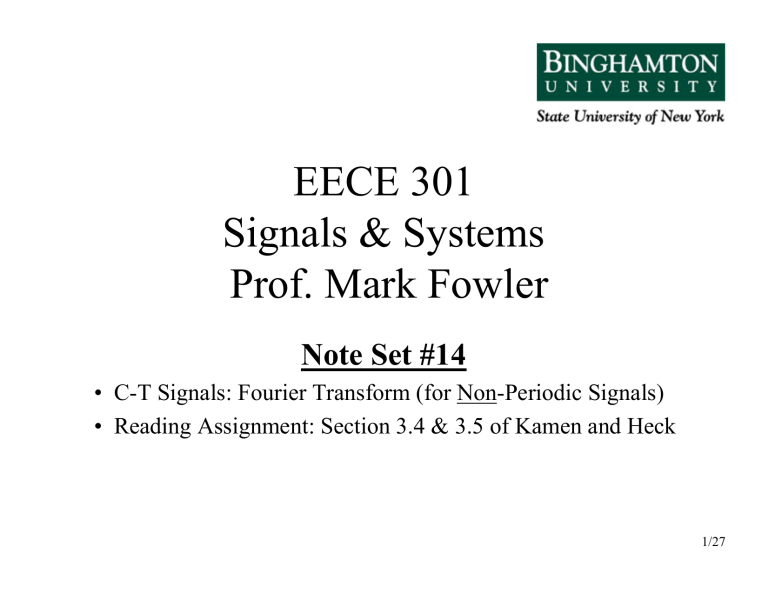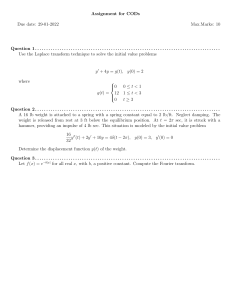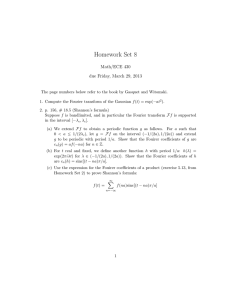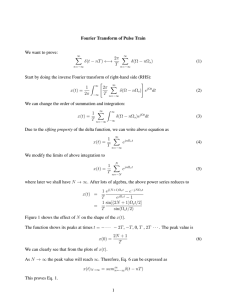
EECE 301
Signals & Systems
Prof. Mark Fowler
Note Set #14
• C-T Signals: Fourier Transform (for Non-Periodic Signals)
• Reading Assignment: Section 3.4 & 3.5 of Kamen and Heck
1/27
Course Flow Diagram
The arrows here show conceptual flow between ideas. Note the parallel structure between
the pink blocks (C-T Freq. Analysis) and the blue blocks (D-T Freq. Analysis).
New Signal
Models
Ch. 1 Intro
C-T Signal Model
Functions on Real Line
System Properties
LTI
Causal
Etc
D-T Signal Model
Functions on Integers
New Signal
Model
Powerful
Analysis Tool
Ch. 3: CT Fourier
Signal Models
Ch. 5: CT Fourier
System Models
Ch. 6 & 8: Laplace
Models for CT
Signals & Systems
Fourier Series
Periodic Signals
Fourier Transform (CTFT)
Non-Periodic Signals
Frequency Response
Based on Fourier Transform
Transfer Function
New System Model
New System Model
Ch. 2 Diff Eqs
C-T System Model
Differential Equations
D-T Signal Model
Difference Equations
Ch. 2 Convolution
Zero-State Response
C-T System Model
Convolution Integral
Zero-Input Response
Characteristic Eq.
D-T System Model
Convolution Sum
Ch. 4: DT Fourier
Signal Models
DTFT
(for “Hand” Analysis)
DFT & FFT
(for Computer Analysis)
Ch. 5: DT Fourier
System Models
Freq. Response for DT
Based on DTFT
New System Model
New System Model
Ch. 7: Z Trans.
Models for DT
Signals & Systems
Transfer Function
New System
Model2/27
4.3 Fourier Transform
Recall: Fourier Series represents a periodic signal as a sum of sinusoids
or complex sinusoids
e jkω0t
Note: Because the FS uses “harmonically related” frequencies kω0, it can only create
periodic signals
Q: Can we modify the FS idea to handle non-periodic signals?
A: Yes!!
What about x(t ) =
∞
∑c e
k = −∞
jω k t
k
?
With arbitrary discrete frequencies…
NOT harmonically related
That will give some non-periodic signals but not some that are
important!!
∞
The problem with x(t ) = ∑ ck e jωk t is that it cannot include all possible
k = −∞
frequencies!
3/27
How about:
1
x(t ) =
2π
Called the “Fourier
Integral” also, more
commonly, called the
“Inverse Fourier
Transform”
∫
∞
−∞
X (ω )e jωt dω
Plays the
role of ck
Yes… this will work for any
practical non-periodic signal!!
Plays the role of
jkω0t
e
Integral replaces sum because it can “add up
over the continuum of frequencies”!
Okay… given x(t) how do we get X(ω)?
∞
X (ω ) = ∫ x(t )e − jωt dt
−∞
Called the
“Fourier Transform”
of x(t)
Note: X(ω) is complex-valued function of ω ∈ (-∞, ∞)
|X(ω)|
∠X (ω )
Need to use two
plots to show it
4/27
Comparison of FT and FS
Fourier Series: Used for periodic signals
Fourier Transform: Used for non-periodic signals (although we
will see later that it can also be used for periodic signals)
Synthesis
Fourier
Series
x(t ) =
∞
∑c e
n = −∞
Analysis
jkω0t
k
Fourier Series
Fourier
Transform
1
x (t ) =
2π
∫
∞
−∞
1 t 0 +T
ck = ∫ x(t )e − jkω0t dt
T t0
Fourier Coefficients
jωt
X (ω )e dω
Inverse Fourier Transform
∞
X (ω ) = ∫ x(t )e − jωt dt
−∞
Fourier Transform
FS coefficients ck are a complex-valued function of integer k
FT X(ω) is a complex-valued function of the variable ω ∈ (-∞, ∞)
5/27
Synthesis Viewpoints:
FS:
x(t ) =
∞
jkω0t
c
e
∑k
n = −∞
|ck| shows how much there is of the signal at frequency kω0
∠ck shows how much phase shift is needed at frequency kω0
We need two plots to show these
FT:
1
x(t ) =
2π
∫
∞
−∞
X (ω )e jωt dω
|X(ω)| shows how much there is in the signal at frequency ω
∠ X(ω) shows how much phase shift is needed at frequency ω
We need two plots to show these
6/27
Some FT Notation:
If X(ω) is the Fourier transform of x(t)…
then we can write this in several ways:
1. x (t ) ↔ X (ω )
2. X (ω ) = F {x (t )}
3. x (t ) = F
−1
{X (ω )}
⇒ F{ } is an “operator” that operates on x(t) to give X(ω)
⇒ F-1{ } is an “operator” that operates on X(ω) to give x(t)
7/27
Analogy: Looking at X(ω) is “like” looking at an x-ray of the signal- in the sense that an
x-ray lets you see what is inside the object… shows what stuff it is made from.
In this sense: X(ω) shows what is “inside” the signal – it shows how much of each complex
sinusoid is “inside” the signal
Note: x(t) completely determines X(ω)
X(ω) completely determines x(t)
There are some advanced mathematical issues
that can be hurled at these comments… we’ll
not worry about them
8/27
FT Example: Decaying Exponential
Given a signal x(t) = e-btu(t) find X(ω) if b > 0
Solution: First see what x(t) looks like:
1
x(t )
b controls decay rate
t
What does this look
like if b < 0???
The u(t) part forces this to zero
Now…apply the definition of the Fourier transform. Recall the general
form:
∞
X (ω ) = ∫ x (t )e − jωt dt
−∞
9/27
Now plug in for our signal:
∞
X (ω ) = ∫ e u (t )e
−bt
−∞
− jωt
∞
dt = ∫ e e
− bt − jωt
0
integrand = 0 for t < 0
due to the u(t)
t =∞
∞
dt = ∫ e −(b + jω ) t dt
0
Set lower limit to 0
and then u(t) = 1 over
integration range
[
Easy
integral!
⎡ − 1 −( b+ jω ) t ⎤
−1
−( b + jω ) ∞
−( b + jω ) 0
e
=
e
−
e
=⎢
⎥
b
j
ω
+
⎦ t =0 b + jω
⎣
]
−1
− 1 ⎡ −b∞ − jω ∞ 0 ⎤
[0 − 1]
=
⎢eN e − eN ⎥ =
b + jω
b + jω ⎢⎣ =0 mag =1 =1 ⎥⎦
1
=
b + jω
Only if b>0… what
happens if b<0
10/27
Summary of FT Result for Decaying Exponential
1
X (ω ) =
b + jω
− bt
x (t ) = e u (t )
For b > 0
(Complex Valued)
X (ω ) =
1
b +ω
2
2
Magnitude
⎛ω ⎞
∠X (ω ) = − tan ⎜ ⎟ Phase
⎝b⎠
−1
X (ω )
x (t ) = e − bt u(t )
1
b > 0 controls
decay rate
t
ω
11/27
(volts)
Fourier Transform of e-btu(t) for b = 10
Technically V/Hz
Note that
magnitude
plot has even
symmetry
Note that
phase plot has
odd symmetry
True for every
real-valued signal
MATLAB Commands to Compute FT
w=-100:0.2:100;
b=10;
X=1./(b+j*w);
Note: Book’s Fig. 3.12 only
shows one-sided spectrum plots
Plotting Commands
subplot(2,1,1); plot(w,abs(X))
xlabel('Frequency \omega (rad/sec)')
ylabel('|X(\omega|) (volts)'); grid
subplot(2,1,2); plot(w,angle(X))
xlabel('Frequency \omega (rad/sec)')
ylabel('<X(\omega) (rad)'); grid
12/27
Time Signal
10
b=0.1
|X( ω)|
x(t)
1
0.5
0
-10
0
10
20
30
b=0.1
5
0
-100
40
Fourier Transform
-50
t (sec)
1
|X(ω )|
x(t)
0.5
0
10
20
30
50
100
50
100
0.5
0
-100
40
1
-50
0
ω (rad/sec)
0.1
b=10
|X( ω )|
b=10
x(t)
100
b=1
t (sec)
0.5
0
-10
50
1
b=1
0
-10
0
ω (rad/sec)
Exploring
Effect of
decay rate b
on the
Fourier
Transform’s
Shape
0
10
20
t (sec)
30
40
0.05
0
-100
-50
0
(rad/sec)
ω
Short Signals have FTs that spread
Note: As b increases…
more into High Frequencies!!!
1. Decay rate in time signal increases
2. High frequencies in Fourier transform are more prominent.
13/27
Example: FT of a Rectangular pulse
τ = pulse width
pτ (t )
Given: a rectangular pulse signal pτ(t)
Find: Pτ(ω)… the FT of pτ(t)
Note the Notational Convention:
lower-case for time signal and
corresponding upper-case for its FT
t
−
τ
τ
2
2
Recall: we use this symbol
to indicate a rectangular
pulse with width τ
Solution:
Note that
τ
τ
⎧
−
≤
≤
1
,
t
⎪
2
2
pτ (t ) = ⎨
⎪0, otherwise
⎩
14/27
Now apply the definition of the FT:
∞
Pτ (ω ) = ∫ pτ (t )e − jωt dt =
−∞
[
− 1 − jωt
=
e
jω
τ
]
2
−τ
2
Limit integral to
where pτ(t) is nonzero… and use the
fact that it is 1 over
that region
τ /2
− jωt
e
∫ dt
−τ / 2
ωτ
−j
⎡ j ωτ2
2 ⎢e − e 2
=
ω⎢
j2
⎢⎣
⎤
⎥
⎥
⎥⎦
⎛ ωτ ⎞
= sin ⎜
⎟
⎝ 2 ⎠
⎛ ωτ ⎞
2 sin⎜
⎟
2 ⎠
⎝
Pτ (ω ) =
ω
Artificially
inserted 2 in
numerator and
denominator
Use Euler’s
Formula
sin goes up and down
between -1 and 1
1/ω decays down as |ω| gets
big… this causes the overall
function to decay down
15/27
For this case the FT is real valued so we can plot it using a single plot
(shown in solid blue here):
τ = 1/2
2/ω
2/ω
-2/ω
⎛ ωτ ⎞
2 sin⎜
⎟
2 ⎠
⎝
Pτ (ω ) =
ω
-2/ω
The
Thesin
sine
wiggles
wiggles
upup
down
&
down
“between
“between
±2/ω”
±2/ω”
16/27
Now… let’s think about how to make magnitude/phase plot…
Even though this FT is real-valued we can still plot it using magnitude
and phase plots:
We can view any real number as a complex
number that has zero as its imaginary part
A positive real number R will have:
|R| = R
∠R = 0
Im
R Re
A negative real number R will have:
|R| = -R
∠R = ±π
Im
+π
R -π
Re
Can use
either one!!
17/27
Applying these Ideas to the Real-valued FT Pτ(ω)
Phase = 0
Phase = ±π
Here I have chosen -π to display odd symmetry
18/27
Effect of Pulse Width on the FT Pτ(ω)
2
τ=2
0.5
0
-4
-3
-2
-1
0
1
t (sec)
2
3
|X( ω )|
x(t)
1
0
-100
4
τ=1
-3
-2
-1
0
1
t (sec)
2
3
|X( ω )|
x(t)
0
-4
0
-4
-2
-1
0
1
t (sec)
2
3
|X( ω )|
x(t)
-50
4
0.5
0
-100
0
(rad/sec)
ω
50
100
0
ω (rad/sec)
50
100
50
100
τ=1
-50
1
τ = 1/2
-3
0.5
0
-100
4
1
0.5
τ=2
1
1
0.5
1
τ = 1/2
-50
0
ω (rad/sec)
Note: As width decreases, FT is more widely spread
Î Narrow pulses “take up more frequency range”
19/27
Definition of “Sinc” Function
The result we just found had this mathematical form:
⎛ ωτ ⎞
2 sin⎜
⎟
⎝ 2 ⎠
Pτ (ω ) =
ω
This kind of structure shows up frequently enough
that we define a special function to capture it:
sin(πx )
Define: sinc ( x ) =
πx
Plot of sinc(x)
Note that sinc(0) = 0/0.
So… Why is sinc(0) = 1?
It follows from
L’Hopital’s Rule
20/27
With a little manipulation we can re-write the FT result for a pulse in terms of the
sinc function:
Recall:
sin(πx )
sinc ( x ) =
πx
Need π times
something…
⎛ ωτ ⎞
⎛ π ωτ ⎞
⎛ ωτ ⎞
2 sin⎜
2
sin
2
sin
⎟
⎜
⎟
⎜π
⎟
2
2
2
π
π
⎝
⎠=
⎝
⎠=
⎝
⎠
Pτ (ω ) =
ω
ω
ω
Now we need
the same thing
down here as
inside the sine…
⎛ ωτ ⎞
⎛ ωτ ⎞
2 sin⎜ π
sin
⎜π
⎟
⎟
τ
2
π
2
π
⎝
⎠ = τ sinc⎛ ωτ ⎞
⎝
⎠ =τ
=π
⎜
⎟
ωτ
2π π τ ω
2
π
⎝
⎠
π
2π
2π
⎛ ωτ ⎞
Pτ (ω ) = τ sinc ⎜
⎟
2
π
⎝
⎠
21/27
Table of Common Fourier Transform Results
We have just found the FT for two common signals…
x ( t ) = e − bt u ( t )
⎧
⎪1,
pτ ( t ) = ⎨
⎪0,
⎩
−
τ
2
≤ t ≤
τ
2
otherwise
X (ω ) =
1
b + jω
⎛ ωτ ⎞
Pτ ( ω ) = τ sinc ⎜
⎟
⎝ 2π ⎠
There are
tables in the
book but I
recommend
that you use
the Tables I
provide on the
Website
See FT Table on the Course Website for a list of these and many other FT.
You should study this table…
•
If you encounter a time signal or FT that is on this table you should recognize
that it is on the table without being told that it is there.
•
You should be able to recognize entries in graphical form as well as in
equation form (so… it would be a good idea to make plots of each function
in the table to learn what they look like! See next slide!!!)
•
You should be able to use multiple entries together with the FT properties
we’ll learn in the next set of notes (and there will be another Table!)
22/27
For your FT Table you should spend time making sketches of the entries
… like this:
X (ω)
t
ω
Pτ (ω)
pτ (t)
t
−
τ
τ
2
2
ω
23/27
Bandlimited and Timelimited Signals
Now that we have the FT as a tool to analyze signals, we can use it to identify
certain characteristics that many practical signals have.
A signal x(t) is timelimited (or of finite duration) if there are 2 numbers T1 & T2
such that:
x(t ) = 0 ∀t ∉ [T1 , T2 ]
T1
T2
t
A (real-valued) signal x(t) is bandlimited if there is a number B such that
X (ω ) = 0
∀ω > 2πB
X (ω )
− 2πB
2πB
2πB is in rad/sec
ω
B is in Hz
Recall: If x(t) is real-valued then |X(ω)| has “even symmetry”
24/27
FACT: A signal can not be both timelimited and bandlimited
⇒ Any timelimited signal is not bandlimited
⇒ Any bandlimited signal is not timelimited
Note: All practical signals must “start” & “stop”
⇒ timelimited ⇒
Practical signals are not bandlimited!
But… engineers say practical signals are effectively bandlimited
because for almost all practical signals |X(ω)| decays to zero as
ω gets large
Recall: sinc decays as 1/ω
X (ω )
FT of pulse
− 2πB
ω
2πB
Some application-specific level
that specifies “small enough to
be negligible”
This signal is effectively bandlimited to B Hz because |X(ω)| falls
below (and stays below) the specified level for all ω above 2πB
25/27
Bandwidth (Effective Bandwidth)
Abbreviate Bandwidth as “BW”
For a lot of signals – like audio – they fill up the lower frequencies but then decay
as ω gets large:
X (ω )
ω
− 2πB
2πB
Signals like this are
called “lowpass” signals
We say the signal’s BW = B in Hz if there is “negligible” content for |ω| > 2πB
Must specify what
“negligible” means
For Example:
1.
High-Fidelity Audio signals have an accepted BW of about 20 kHz
2.
A speech signal on a phone line has a BW of about 4 kHz
Early telephone engineers determined that limiting speech to a BW
of 4kHz still allowed listeners to understand the speech
26/27
For other kinds of signals – like “radio frequency (RF)” signals – they
are concentrated at high frequencies
Signals like this are
called “bandpass” signals
X (ω )
ω
− ω2
− ω1
ω1 = 2πf1
ω2 = 2πf 2
If the signal’s FT has negligible content for |ω| ∉ [ω1, ω2]
then we say the signals BW = f2 - f1 in Hz
For Example:
1. The signal transmitted by an FM station has a BW of 200 kHz = 0.2 MHz
a. The station at 90.5 MHz on the “FM Dial” must ensure that its signal
does not extend outside the range [90.4, 90.6] MHz
b. Note that: FM stations all have an odd digit after the decimal point.
This ensures that adjacent bands don’t overlap:
i. FM90.5 covers [90.4, 90.6]
ii. FM90.7 covers [90.6, 90.8], etc.
2. The signal transmitted by an AM station has a BW of 20 kHz
a. A station at 1640 kHz must keep its signal in [1630, 1650] kHz
b. AM stations have an even digit in the tens place and a zero in the ones
27/27








